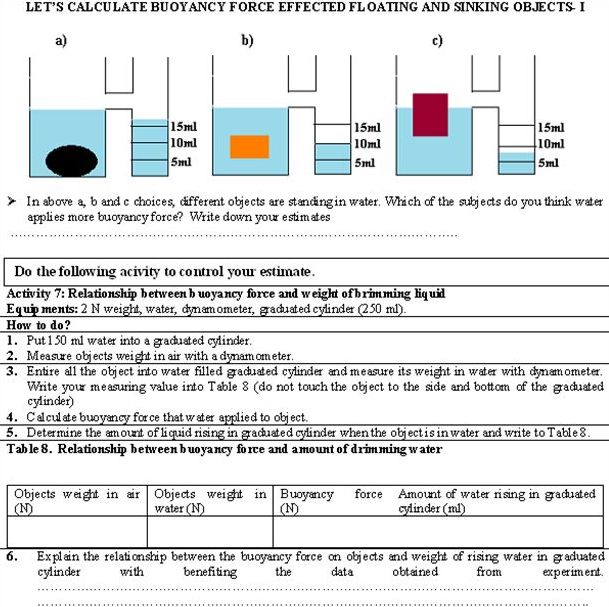Asia-Pacific Forum
on Science Learning and Teaching, Volume 11, Issue 2, Article 5 (Dec., 2010) |
Appendix 1
Appendix 2
1. The worksheet called "Let's Calculate the Buoyancy Force Effecting Floating and Sinking Objects–I" is given to students. The purpose of these activities is to establish the relationship between buoyancy force and the amount of liquid brimming over the object.
2. Let students complete "Activity 7."
3. At the end of Activity 7 students are expected to make a generalization like "buoyancy force affected on an object is equal to the weight of water that it causes to overflow." Note: As the Formula W=m.g was not given to students, you should calculate the weight of water rising in graduated cylinder in Newton's terms. For example, the weight of 20 ml is equal to 0.2 Newton.
4. Students are also expected to respond to the question at the beginning of the worksheet. The answer to the question must be "more buoyancy force will effect on object" found in choice A because the object in this bucket cause to overflow more water. Objects cause an overflow equal to their volume. As the buoyancy force effecting an object is related to the volume of the objects sinking in water, more buoyancy force is effecting choice A.
5. Give students the worksheet called "Let's Calculate the Buoyancy Force Effecting Floating and Sinking Objects–II." The aim of this worksheet is to establish the relationship between buoyancy force and equilibrium condition of the object. Students are expected to make a conclusion like "objects should be hanging or floating with leaving some part of itself at the surface of water in equilibrium condition."
6. Note: Students think hanging is a different situation then floating. An emphasis should be put on hanging is also a floating situation.
7. Students should do Activity 8 to understand this situation clearly.
Appendix 3
Figure 3. Animation screen called “Floating and sinking”
Figure 4. Animation screen called “Floating and sinking” (when you see objects mass, volume and density)
Figure 5. Animation screen about situations of key, plate and tray




